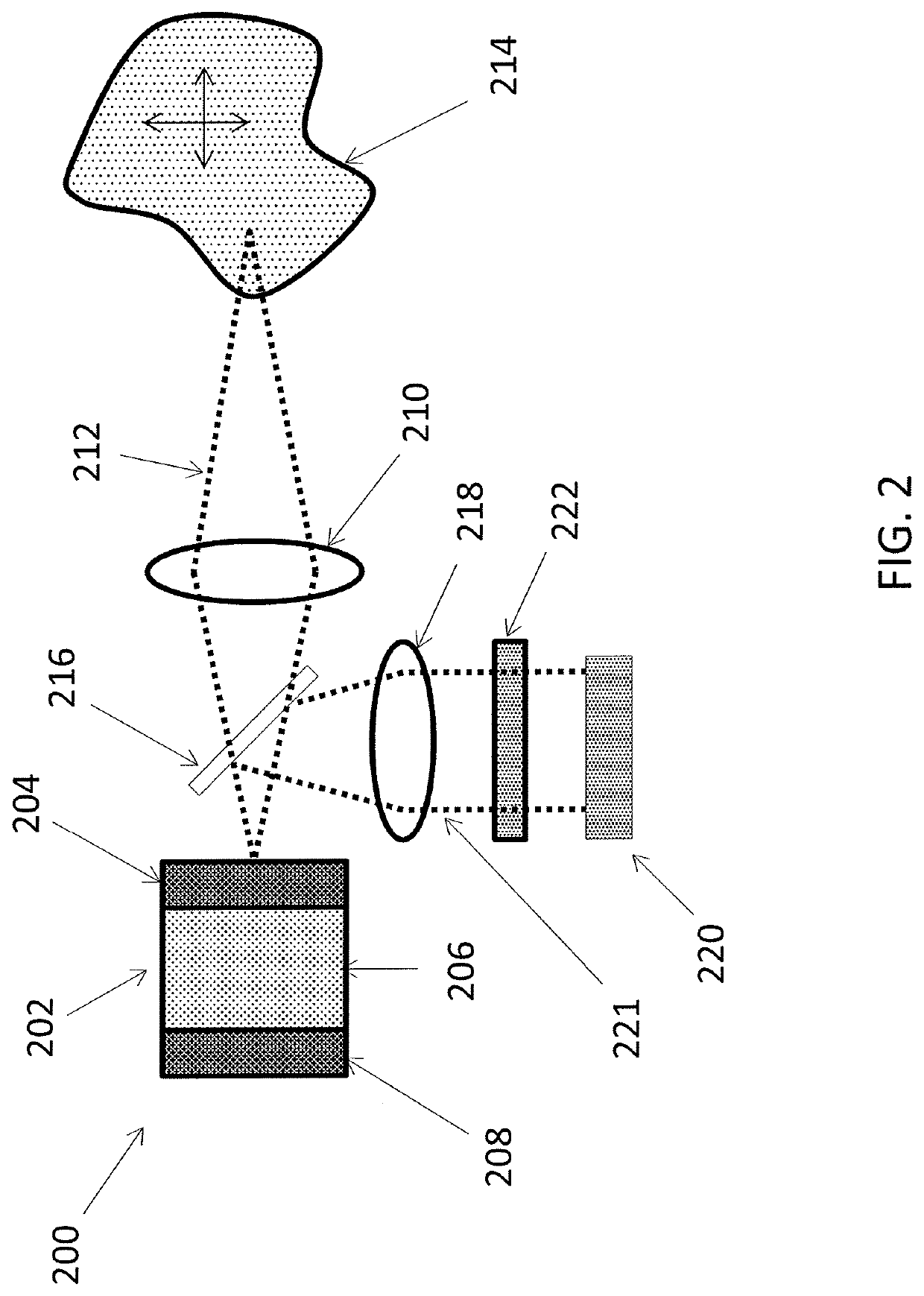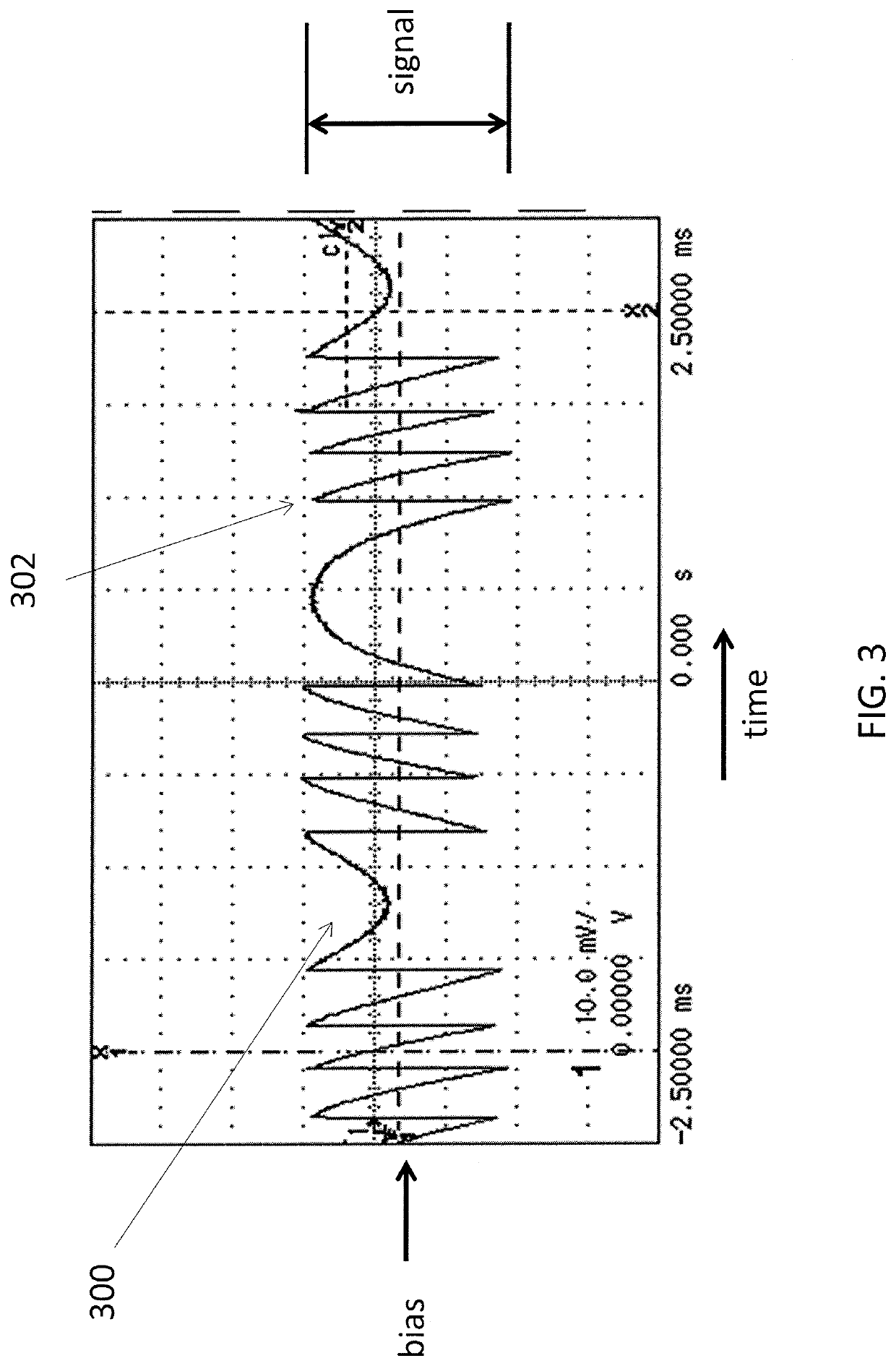[0009]The systems and methods of the present disclosure may include, for example, systems, devices, and methods for improved self-mixing by utilizing a filter, particularly a Fabry-Perot filter. The systems and methods of the present disclosure may also include, for example, systems, devices, and methods for improved self-mix sensors utilizing VCSELs, particularly VCSELs designed for increased levels of bottom emission or integrated with etalons. The systems and methods of the present disclosure may provide other and / or additional benefits or advantages.
[0010]In light of the outlined limitations in scalability and sensitivity of self-mixing sensors, it is an objective of one or more embodiments of this disclosure to provide a means with which to effectively amplify the output signal from a self-mixing device. At least one embodiment of the present disclosure is based on the use of a wavelength filter, preferably a Fabry-Perot etalon, to enhance the signal amplitude by operating at a wavelength on the edge of one of the filter passbands. The wavelength filter is therefore placed in the optical path of the monitoring signal, prior to the detector. It is a further objective of one or more embodiments of this disclosure to enable smaller, more cost-effective self-mixing sensors through the use of vertical-cavity lasers. Specifically, by utilizing the substrate-side (back) emission from a VCSEL, there is no need for a separate beam-splitter component, and an efficient vertically-stacked packaging configuration may be enabled. Still another objective of at least one embodiment of the disclosure is to leverage the unique structure of the VCSEL in order to directly integrate the filter into the VCSEL structure itself.
[0013]The purpose of the filter is to provide a signal to the detector that is very sensitive to the wavelength of the sampled laser beam such that very small changes in wavelength cause large changes in transmission or reflection characteristics of the filter. In other words, the probability of a photon in the sampled self-mix modulated light reaching the detector after encountering the filter depends strongly on its wavelength. Since it is in the physical nature of self-mixing signals to exhibit wavelength modulation in time synchronicity with amplitude or intensity modulation, the filter can act to as to effectively amplify or suppress the signal available for detection.
[0014]The laser may be operated such that the wavelength of the emitted light corresponds to a region of relatively steep change in the filter transmission or reflection characteristics. If operating on a rising edge of the filter characteristic, where the transmission or reflection is increasing as wavelength is increasing, and the increase in the intensity of the sampled light signal is accompanied by a shift to longer wavelength, the effect is additive (in phase) and the apparent peak-to-peak modulation of the signal will be increased. If operating on a falling edge of the filter characteristic, where the transmission or reflection is decreasing as wavelength is increasing, and the increase in the intensity of the sampled light signal is accompanied by a shift to longer wavelength, the effect is subtractive (out of phase) and the apparent peak-to-peak modulation of the signal will be reduced. If operating on a rising edge of the filter characteristic, where the transmission or reflection is increasing as wavelength is increasing, and the increase in the intensity of the sampled light signal is accompanied by a shift to shorter wavelength, the effect is subtractive (out of phase) and the apparent peak-to-peak modulation of the signal will be reduced. If operating on a falling edge of the filter characteristic, where the transmission or reflection is decreasing as wavelength is increasing, and the increase in the intensity of the sampled light signal is accompanied by a shift to shorter wavelength, the effect is additive (in phase) and the apparent peak-to-peak modulation of the signal will be increased.
[0016]A further aspect of various embodiments disclosed herein is the reduction of packaging size and complexity by using a substrate-emitting VCSEL laser. Typical VCSELs are designed with a very high reflectivity bottom mirror (>99.9%), and as such almost all of the optical power is emitted through the top surface mirror with a lower reflectivity, typically <99.6%. By reducing the reflectivity of the bottom mirror, the amount of laser light emitted through the substrate can increase. If the VCSEL is then mounted in a position above the detector, this bottom-emitted light is available for monitoring the self-mix signal. Thus, the need for a beam splitter is removed. The VCSEL can be stacked directly on the detector or set at a distance with an intermediate air gap. The partially bottom emitting VCSEL is advantageous for packaging with an etalon. Preferably, the VCSEL has patterned metal on the substrate side with holes or apertures which serve to let the laser light pass while suppressing unwanted spontaneous emission light. The presence of spontaneous emission at the detector can cause an unwanted detector signal that degrades the signal-to-noise ratio. The substrate emitting surface may also be coated with a low-reflectivity coating to reduce signal loss, improve linearity of the laser power emission as a function of injected current, and reduce or minimize perturbations to the laser cavity light itself.
[0017]To further reduce sensor size, cost, and packaging complexity while improving performance, embodiments disclosed herein may utilize a VCSEL laser directly integrated with an etalon. The VCSEL, being in part comprised of a highly reflective mirror adjacent to an optically transparent substrate, can incorporate the etalon filtering functionality by coating the substrate final surface with a highly-reflective (HR) mirror coating. In such case the substrate is itself the cavity spacer region of the etalon, bounded on one side by the VCSELs bottom DBR and by the HR coating on the other. Due to the divergence of the beam and the small beam diameter of the laser illumination within the etalon cavity, the expected performance may not be ideal, but may prove adequate to yield significant signal enhancement.
 Login to View More
Login to View More 


